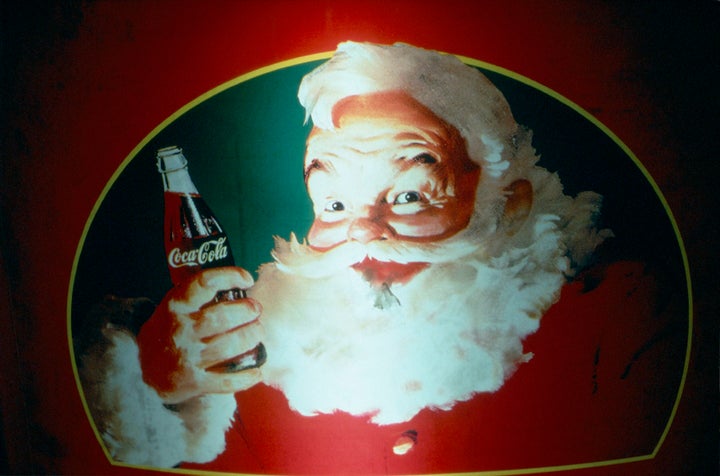
Now that Bonfire Night has passed in the UK, it doesn’t feel too soon to talk about Christmas and where better to start than with Father Christmas himself?
Though we associate him with delivering presents, saying “ho-ho-ho!” and keeping a certain red-nosed reindeer in employment, there’s actually a lot more to the mythical figure than you probably realise.
Facts about Father Christmas you might not have known
Here in Europe, before we had Father Christmas, we had Sinterklaas
So, according to English Heritage, the origins of Sinterklaas can be found in the stories of Saint Nicholas, a 4th century bishop from Myra, which is now modern-day Turkey. Sinterklaas was depicted as an elderly, stately, serious man with white hair and a long, full beard. He also carries around a big red book which records whether each child has been good or naughty in the past year. Sound familiar?
Sinterklaas eventually made his way across the North Atlantic to North America where he was soon renamed “Santa Claus”. Historians aren’t 100% sure how he made it over there but English Heritage suggests that his story made his way to the Dutch colony of New Amsterdam, which later became New York.
St Nicholas was thought to have performed miracles
More than just making a list and checking it twice, St Nicholas was thought to have performed jaw-dropping miracles. In one story, he resurrected three youths after they’d been murdered and pickled in a barrel by an innkeeper. Not very Christmassy of the innkeeper, is it?
The first story of his miracles, though, actually took place during his baptism. The story goes that as a newborn infant, he stood on his feet for three hours in honour of the Trinity. The Trinity is God the Father, God the Son and God the Holy Spirit.
Saint Nicholas was very generous
Another story tells the tale of him rescuing three maidens from being forced into prostitution. According to legend, word got to him that the family had fallen onto financially hard times and in the middle of the night, he tossed a bag of gold into the house. It sailed through a window and landed in a stocking that was drying by the fire.
Soon after this, the first daughter got married.
Not long after, another bag of gold appeared mysteriously, leading to the second daughter getting married.
Finally, one night, their suspicious father stayed up to see who was dropping these bags of gold in the dark and when he met Saint Nicholas he cried out: “You have saved my daughters from certain disaster.”
Santa and Father Christmas were not always thought to be the same person
Originally, Father Christmas was actually a pagan figure representing the coming of Spring, who wore a long hooded green cloak and a wreath of ivy, mistletoe, or holly. However, when Britain was under Saxon rule in the 5th and 6th centuries, he took on the attributes of the Saxons’ Father Time (or King Winter).
Back then, people believed that if they were kind to King Winter, they’d get a milder winter and this is thought to be the early formations of Father Christmas and receiving good things. While we once we behaved so that we’d get a mild winter, now we do so because we want a PlayStation. Love that for us.
Then, the Vikings added to the tradition with their own. The Norse god Odin took on the character of Jul, a portly old man who gave gifts to good people and punishments to bad people.
These were then blended with the Norman stories of St Nicholas (Sinterklaas and later, Santa Claus) and all of them blended into what we now know as Father Christmas. From the 15th Century onwards, Father Christmas has been seen as the spirit of Christmas, provoking thoughts of family, generosity, and kindness.

The image of Father Christmas that we know today is actually due to... Coca Cola
Is it actually Christmas if you haven’t sung along to, “always Coca Cola”? The brand has firmly made itself a Christmas advertisement staple despite not really having any of the attributes we usually think of when it comes to Christmas and it all started way back in 1931.
While there have been a lot of obvious inspirations along the way from legends, the poem Twas The Night Before Christmas and from an illustration by Thomas Nast for Haper’s Weekly back in 1863, the final depiction of our Christmas mascot was actually defined by Coca Cola advertisements illustrated by Haddon Sandblum, according to Brittanica.
Rudolph is... quite a bit younger than his colleagues
Father Christmas’s reindeer Rudolph, considered to be the most famous reindeer of all time was actually born over 100 years after his eight counterparts, according to Sky History.
He was actually the creation of a copywriter named Robert L. May who worked at the Montgomery Ward department store.
May wrote a Christmas-themed story-poem to bring people into his store. He used the familiar rhyming pattern to “Twas The Night Before Christmas” and told the story of the now famous reindeer who was bullied for his bright red nose.
He went on to sell almost two and a half million copies of the story in 1939 and when it was reissued in 1946, the book sold three and a half million copies. Whew!
It didn’t end there, though. The story was then made into a song by May’s friend Johnny Marks, recorded by Gene Autry and went on to sell over two million copies.
May’s story has since been translated into 25 languages, made into a television movie and is a mainstay in many children’s Christmas memories.